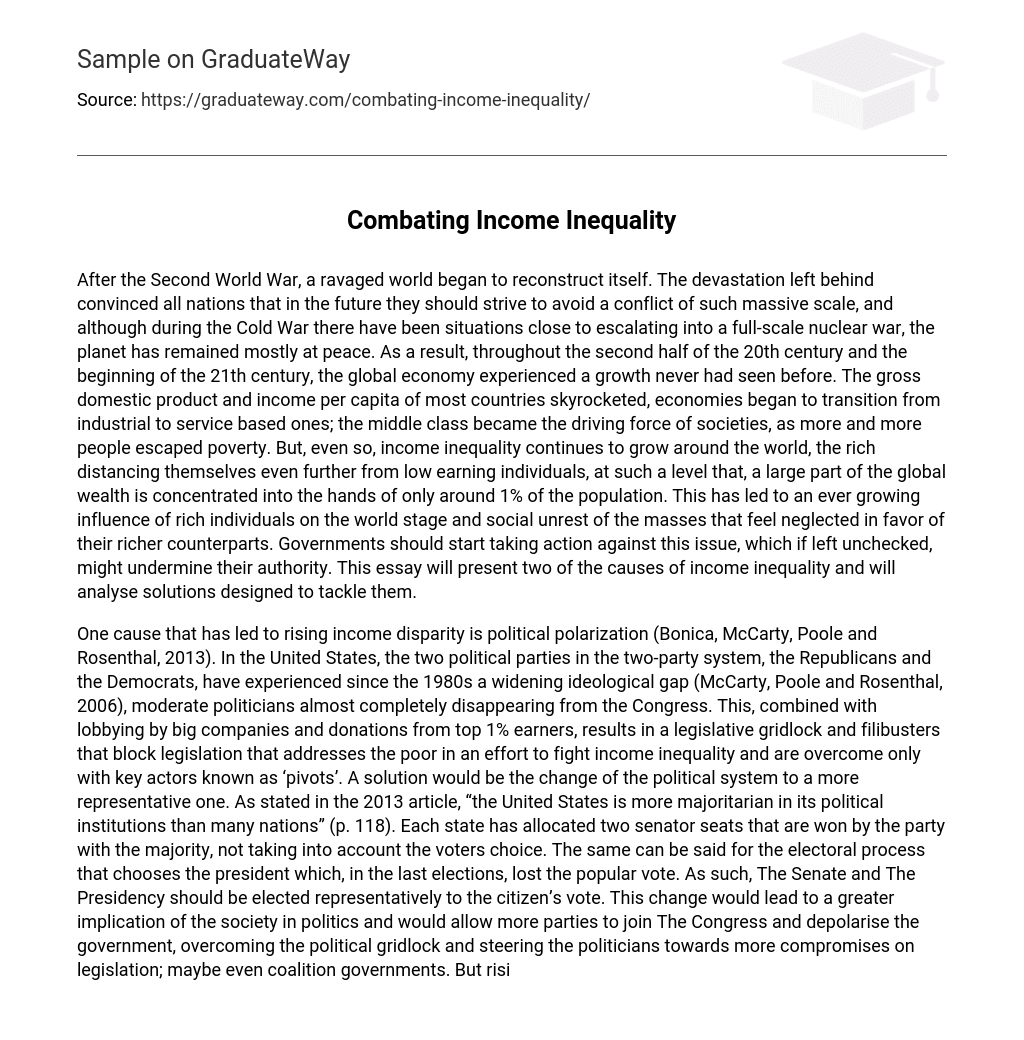After the Second World War, a ravaged world began to reconstruct itself. The devastation left behind convinced all nations that in the future they should strive to avoid a conflict of such massive scale, and although during the Cold War there have been situations close to escalating into a full-scale nuclear war, the planet has remained mostly at peace. As a result, throughout the second half of the 20th century and the beginning of the 21th century, the global economy experienced a growth never had seen before. The gross domestic product and income per capita of most countries skyrocketed, economies began to transition from industrial to service based ones; the middle class became the driving force of societies, as more and more people escaped poverty. But, even so, income inequality continues to grow around the world, the rich distancing themselves even further from low earning individuals, at such a level that, a large part of the global wealth is concentrated into the hands of only around 1% of the population. This has led to an ever growing influence of rich individuals on the world stage and social unrest of the masses that feel neglected in favor of their richer counterparts. Governments should start taking action against this issue, which if left unchecked, might undermine their authority. This essay will present two of the causes of income inequality and will analyse solutions designed to tackle them.
One cause that has led to rising income disparity is political polarization (Bonica, McCarty, Poole and Rosenthal, 2013). In the United States, the two political parties in the two-party system, the Republicans and the Democrats, have experienced since the 1980s a widening ideological gap (McCarty, Poole and Rosenthal, 2006), moderate politicians almost completely disappearing from the Congress. This, combined with lobbying by big companies and donations from top 1% earners, results in a legislative gridlock and filibusters that block legislation that addresses the poor in an effort to fight income inequality and are overcome only with key actors known as ‘pivots’. A solution would be the change of the political system to a more representative one. As stated in the 2013 article, “the United States is more majoritarian in its political institutions than many nations” (p. 118). Each state has allocated two senator seats that are won by the party with the majority, not taking into account the voters choice. The same can be said for the electoral process that chooses the president which, in the last elections, lost the popular vote. As such, The Senate and The Presidency should be elected representatively to the citizen’s vote. This change would lead to a greater implication of the society in politics and would allow more parties to join The Congress and depolarise the government, overcoming the political gridlock and steering the politicians towards more compromises on legislation; maybe even coalition governments. But rising income inequality, as a result of political polarisation, appears mostly in the United States (Fenzl, 2018) or countries that have similar political systems. Elsewhere, the increasing disparity leads political parties towards having the same stance on economic policy, therefore mitigating the cause. Also, even though the society is in favour of political change, politicians might refuse it, leading to protests and insurrection of the masses, which would have disastrous effects on the economy and the credibility of the executive.
Kochan and Riordan (2016) state that another factor that influences income inequality is skilled-biased technological change (SBTC). The demand for highly-skilled workers increases as technology evolves, creating a shortage in the availability of those individuals, while later intensifying the competition for lower-earning jobs of lower- and middle-skilled workers by requiring them to increase their mobility. Others argue for the emergence of “job polarisation”, a reduction in middle-skill workplaces in favor of more low- and high-skill jobs which result in employees either having a low or high income. Thus, education reforms and better collaboration between companies and teaching institutions are needed for reducing SBTC, hence income disparity. Although change in educational policy requires money and time to perfect, education being a long-term investment, it is undoubtedly needed for “a highly educated, skilled and innovative workforce”, which could support high-wage economies, in a globalised world where human capital can be outsourced. Reforms could, over time, increase the availability of a better trained workforce and reduce the differences in income, while also diminishing the need for outsourcing.
In conclusion, rising income inequality can be tackled through different methods that address certain causes. Political reform is one of them and is needed for a government to remain credible and fight this issue, but as stated above, political polarisation on economic issues is not present in most democratic countries and can only be applied in a few to resolve the problem. Educational reforms are a better solution, as they can be applied on a larger scale, although they imply large capital and time consumption, they have always led to the advancement of societies, from agrarian to industrial to service based, and lower differences between classes, overall increasing the standards of living across the world.





